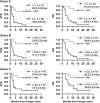Blood Immune Cell Biomarkers in Patient With Lung Cancer Undergoing Treatment With Checkpoint Blockade
- PMID: 31592989
- PMCID: PMC7012348
- DOI: 10.1097/CJI.0000000000000297
Blood Immune Cell Biomarkers in Patient With Lung Cancer Undergoing Treatment With Checkpoint Blockade
Abstract
Characterization of host immune cell parameters before and during immunotherapy is expected to identify predictive biomarkers for clinical outcome. We prospectively monitored blood immune cells from 35 patients with advanced non-small cell lung cancer undergoing checkpoint inhibitor monotherapy. The aim was to identify parameters correlating with better/worse outcome. Peripheral blood was serially collected before each infusion at the onset and at cycle 3 and 5 of immunotherapy. A complete leukocyte blood count, the lymphocytic subpopulations and the percentages of both HLA-DR monocytes and dendritic cells (DC) were monitored. Disease control was defined as partial/complete response and stable disease on computed tomography scan according to RECIST 1.1. The predictive value of the immune cell parameters investigated was evaluated by patients' survival analysis. Forty percent of patients showed a clinical response, and the global median overall survival was 7.0 months (95% confidence interval: 3.5-10.5). Patients with an initial neutrophil-to-lymphocyte ratio (NLR) ≥5.2, and/or an amount of HLA-DR monocytes ≥11% and/or a total DC level ≤0.4% of leukocytes did rarely respond to PD-1 inhibitor therapy. Otherwise, the immunotherapy-induced decrease of the neutrophil-to-lymphocyte ratio and/or HLA-DR monocytes and the increase of total DC frequencies were correlated with improved therapy response and prolonged overall survival. Blood values in the third cycle of immunotherapy did already reflect the effects observed. On the basis of the 3 immune cell parameters identified we created 3 different variants of scores that enable to stratify patients into groups of risk/therapy response. Our results warrant further investigation in larger prospective clinical trials for validation.
Figures



Similar articles
-
Blood immune cell biomarkers in lung cancer.Clin Exp Immunol. 2019 Feb;195(2):179-189. doi: 10.1111/cei.13219. Epub 2018 Nov 9. Clin Exp Immunol. 2019. PMID: 30246868 Free PMC article.
-
Peripheral blood markers predictive of outcome and immune-related adverse events in advanced non-small cell lung cancer treated with PD-1 inhibitors.Cancer Immunol Immunother. 2020 Sep;69(9):1813-1822. doi: 10.1007/s00262-020-02585-w. Epub 2020 Apr 29. Cancer Immunol Immunother. 2020. PMID: 32350592 Free PMC article.
-
Monitoring Blood Immune Cells in Patients with Advanced Small Cell Lung Cancer Undergoing a Combined Immune Checkpoint Inhibitor/Chemotherapy.Biomolecules. 2023 Jan 17;13(2):190. doi: 10.3390/biom13020190. Biomolecules. 2023. PMID: 36830562 Free PMC article.
-
Emerging Blood-Based Biomarkers for Predicting Response to Checkpoint Immunotherapy in Non-Small-Cell Lung Cancer.Front Immunol. 2020 Oct 16;11:603157. doi: 10.3389/fimmu.2020.603157. eCollection 2020. Front Immunol. 2020. PMID: 33178229 Free PMC article.
-
Predictive value of neutrophil-lymphocyte ratio and platelet-lymphocyte ratio in non-small cell lung cancer patients treated with immune checkpoint inhibitors: A meta-analysis.Int Immunopharmacol. 2020 Aug;85:106677. doi: 10.1016/j.intimp.2020.106677. Epub 2020 Jun 9. Int Immunopharmacol. 2020. PMID: 32531712
Cited by
-
Therapeutic and Systemic Adverse Events of Immune Checkpoint Inhibitors Targeting the PD-1/PD-L1 axis for Clinical Management of NSCLC.Cell Transplant. 2021 Jan-Dec;30:9636897211041587. doi: 10.1177/09636897211041587. Cell Transplant. 2021. PMID: 34606729 Free PMC article. Review.
-
Evaluation of immunotoxicity of sodium metavanadate following drinking water exposure in female B6C3F1/N mice in a 28-day study.J Appl Toxicol. 2023 Nov;43(11):1686-1701. doi: 10.1002/jat.4508. Epub 2023 Jul 5. J Appl Toxicol. 2023. PMID: 37403832 Free PMC article.
-
The Importance of Predictive Biomarkers and Their Correlation with the Response to Immunotherapy in Solid Tumors-Impact on Clinical Practice.Biomedicines. 2024 Sep 22;12(9):2146. doi: 10.3390/biomedicines12092146. Biomedicines. 2024. PMID: 39335659 Free PMC article. Review.
-
Inflammation-based Prognostic Score as a Prognostic Biomarker in Patients With Recurrent and/or Metastatic Head and Neck Squamous Cell Carcinoma Treated With Nivolumab Therapy.In Vivo. 2022 Mar-Apr;36(2):907-917. doi: 10.21873/invivo.12780. In Vivo. 2022. PMID: 35241549 Free PMC article.
-
Inflammatory and autoimmune predictive markers of response to anti-PD-1/PD-L1 therapy in NSCLC and melanoma.Exp Ther Med. 2022 Jul 5;24(3):557. doi: 10.3892/etm.2022.11495. eCollection 2022 Sep. Exp Ther Med. 2022. PMID: 35978940 Free PMC article.
References
-
- Scagliotti GV, Bironzo P, Vansteenkiste JF. Addressing the unmet need in lung cancer: the potential of immuno-oncology. Cancer Treat Rev. 2015;41:465–475. - PubMed
-
- Gandini S, Massi D, Mandala M. PD-L1 expression in cancer patients receiving anti PD-1/PD-L1 antibodies: A systematic review and meta-analysis. Crit Rev Oncol Hematol. 2016;100:88–98. - PubMed
-
- Rizvi H, Sanchez-Vega F, La K, et al. Molecular determinants of response to anti-programmed cell death (PD)-1 and anti-programmed death-ligand 1 (PD-L1) blockade in patients with non-small-cell lung cancer profiled with targeted next-generation sequencing. J Clin Oncol. 2018;36:633–641. - PMC - PubMed
MeSH terms
Substances
LinkOut - more resources
Full Text Sources
Medical
Research Materials

